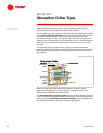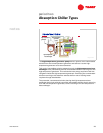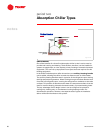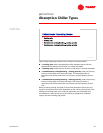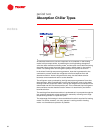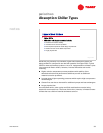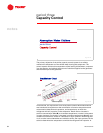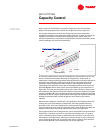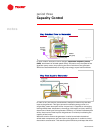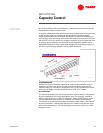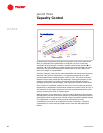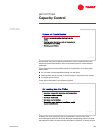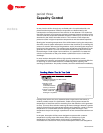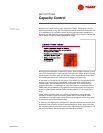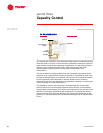
TRG-TRC011-EN 35
period three
Capacity Control
notes
other words, the combination of solution temperature and concentration
determines the temperature at which the refrigerant will boil (vaporize).
Varying the temperature at which the refrigerant boils in the evaporator
changes the capacity of the absorption water chiller. So, in order to control the
capacity of the chiller to meet the ever-changing system loads, either the
solution temperature or the solution concentration must be varied. Many chiller
control strategies vary both simultaneously.
A common method used to vary the temperature of the solution is to vary the
amount of absorbent solution delivered to the generator. At part load, in
response to a changing leaving-chilled-water temperature, less dilute solution is
pumped to the generator, reducing the heat energy required to boil off the
refrigerant vapor. Reduced heat input results in less refrigerant boiled off
(vaporized) in the generator and a less-concentrated solution returning to the
absorber (', 56% shown here at part load versus 64.5% at full load shown in
Figure 20). This less-concentrated solution has a lower affinity for water vapor
and, therefore, the pressure inside the absorber–evaporator sections increases
(pressures at $ and )). This increased pressure causes the refrigerant inside the
evaporator to boil at a higher temperature, reducing the temperature difference
between the chilled water and the refrigerant, thus reducing the chiller’s
capacity.
Because less refrigerant is boiled off in the generator, the refrigerant flow rate
through the cycle is decreased. Consequently, the heat rejected within the
absorber is less. Less heat rejected by the cooling tower typically results in
lower-temperature water returning from the tower, which tends to increase the
capacity of the chiller and further reduces heat input to the generator.
Varying the solution flow to the generator can be accomplished in several ways.
Historically, it has been common to use either a throttling valve or a bypass
valve. A throttling valve creates an additional flow restriction in the pipe from
the absorber to the generator, allowing the solution pump to ride up its pump
curve, reducing the flow rate. A bypass valve diverts a portion of the solution
back into the absorber, thus reducing the flow to the generator.
6
5
6
5
6
0
6
0
5
5
5
5
5
0
5
0
4
0
4
0
50°F
50°F
[10°C]
[10°C]
100°F
100°F
[37.8°C]
[37.8°C]
150°F
150°F
[65.6°C]
[65.6°C]
200°F
200°F
[93.3°C]
[93.3°C]
$
$
%
%
&
&
'
'
(
(
)
)
15
15
psia
psia
[103.4
[103.4
kPa
kPa
]
]
5
5
psia
psia
[34.5
[34.5
kPa
kPa
]
]
1
1
psia
psia
[6.9
[6.9
kPa
kPa
]
]
0.1
0.1
psia
psia
[0.69
[0.69
kPa
kPa
]
]
LiBr
LiBr
solution
solution
v
a
p
o
r
p
r
e
s
s
u
r
e
v
a
p
o
r
p
r
e
s
s
u
r
e
concentration
concentration
concentration
solution temperature
solution temperature
Figure 41




